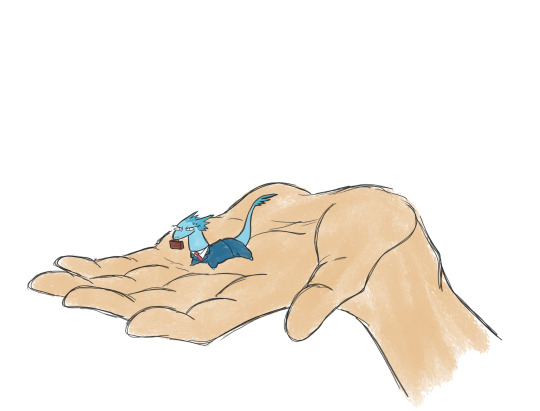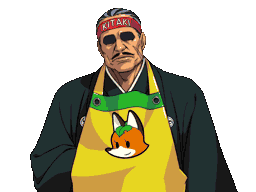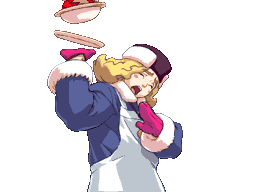#point me to the Spark Brushel fans
Note
you are so real for having phoenix as a favorite he's the best character out of everyoen 🙏🙏 he makes me happy by looking at him
we all need a phoenix wright in our lives
It's dangerous to go alone take this

Haha thanks, and yes the blorbo makes us happy. I like your enthusiasm. Not sure if this was meant as just a private message but sorry I had to draw this...
#ace attorney#ace attorney fanart#fanart#phoenix wright#ask#if we all need one it makes sense to make him pocket sized no?#yes im going to continue drawing him as a tiny blue dragon#I don't think I deserve the title of so real#point me to the Spark Brushel fans
78 notes
·
View notes
Text
Fave Sprites in each AA Game: AJ
(Spoilers for Apollo Justice)
Fourth game in the series. This game marked a turning point in the series for a bunch of very obvious gameplay-related reasons, but it also marked a huge change of direction in the art direction: Characters had way more animations, they were more detailed, had more frames, they even had the perceive animations which required an extremely detailed and large sprite to be created. I think this game is tied with another one later on for my favourite overall art direction in the whole series. There's only a single character design I truly despise, and he's not that b- Okay, actually Spark Brushel really is that bad. Anyways, I'm dragging on; Let's get to it!
(Oh btw I have other posts in this series so check them out if you like this one.)
Animation 1:

Something you'll notice in this batch of animations is that a majority of my favourite sprites come from the main characters (defense attorney, designated weird little girl, prosecutor).
My other posts in the series don't tend to include these repeating animations because they repeat often and quickly grow tiring. But not in this game. These animations fucking slap and do so much to make these characters endearing.
Let's just look at this Apollo animation: He's so embarrassed! Not only are his shoulders positioned in a way that's already giving away that he's flustered, but he's blushing, he has an awkward smile on, and he's nervously playing with his hair. Starting in this game we begin to get actual animations; his hair has anticipation and followthrough (two of the most important animation principles to get an object to look cartoonish and playful).
It's a very charming sprite and makes Apollo extremely endearing to the player.
Animation 2:

Man... I really miss Klavier :(
Anyways, let's not get too down in the dumps; we should enjoy this wonderful animation instead. First of all, look at those HANDS. The detail and secondary actions in this sprite are what really tie everything together. He's so committed to his air guitar and he has a charming smug smile on; it's impossible not to playfully roll your eyes.
I'm also a really big fan of long animations with a purpose. Something like uh... Solomon Starbuck's sigh in 5-4 is just kind of annoying and there to drag out the game. With Klavier however, the animation has a purpose! It makes us roll our eyes at this dumb music nerd along with Apollo. We also know that he's probably gonna make a point, which gets us thinking ahead about what his counterargument might turn out to be.
This sprite is really good from an animation standpoint and a gameplay one.
Animation 3:

It's the SQUIMPSY!!! The TRUCY OF ALL TIME! DUDE, YES!
I had to choose between this and her Mr. Hat sprite, but settled on this simple idle animation. I really like it when characters still move even when they're not talking, and I don't just mean their blinking.
There's so much followthrough and secondary action in this sprite that it makes me want to explode because it's so fucking good. Just watch the loop a couple times and try to focus on a different part each time; do you see how much detail there is?
Her red scarf? Moves. Her hair and earring? They move too. The little jangly bits at the end of her cape? You guessed it; they MOVE!
What a banger of a sprite. Touché, Ace Attorney artists. Touché.
Animation 4:

THE BETRAYAL! THE COMEDY! THE TRICKERY! THE ABSURDITY OF THE WHOLE CHARACTER AND DESIGN!
Forget "Farewell, My Turnabout" or "Turnabout Trump": THIS is the most surprised I felt in the whole series (I'm only half-joking).
This sprite is one of the funniest visual gags in the series, and it deserves a place on this list.
Animation 5:

I just had to include this animation. Every once in a while, a sprite will stick with you, and you'll sometimes remember that moment better than the rest of the case. This was one of those times.
These types of animations and the ones I've mentioned in other posts (Adrian's card flipping ,Ron's hair springs ,Winfred's eyebrows) are kind of the whole reason I even began making these lists.
I wanted to showcase how sometimes the best animations aren't extremely elaborate, show-stopping displays of storytelling prowess. Sometimes it's just a girl catching some plates :]
(Oh but also this is a good hint that Olga may be more than meets the eye. Her reflexes seem to be a little too good for the bumbling, shy waitress she's pretending to be.)
That'll do it for now. See you next time in our first (but not last) very big deviation in how these games art style is showcased; Ace Attorney Investigations 1!
#ace attorney#ace attorney apollo justice#apollo justice#klavier gavin#trucy wright#winfred kitaki#olga orly#AA Best Sprites#animations#sprite rating
23 notes
·
View notes
Note
If you were the an Executive, Producer or some other kind of superior that has the authority at Capcom during the making of the Ace Attorney-series, would there be cases that you would order to be rewritten or designs of characters you would order to be changed?
Yes. Loads of things, really. Because I’m more of a writer than, say, a producer, I think of the cases from the perspective of their scenarios, rather than what churns the most bucks or what would be most time-efficient. I probably wouldn’t make a very good executive in that case, but hey, that’s makes me a writer.
For the record, I don’t find any particular case in the canon “bad”. Some may be disappointing, but “disappointment” comes in so many flavors other than “bad”.
While I could discuss every single case in detail and what I would offer that may improve on them, they would make up an entire book(let) on their own. So, I’ll just drop a few pointers on the general direction of the series and the games. Hey, they can make good writing advice too.
1. Innovate for the sake of innovating, not for the sake of hype.
I feel this is something that is lacking among many amateur and professional writers, alike. Sometimes these authors just want to throw in a huge twist into the drama just for shock value. It’s fair to want to hype up your story, but if you’re able to write suspense well, you don’t need a big twist. A little one that catches the reader’s attention for a bit is enough.
Since AA has a long-running history of building upon previous surprises and twists, I notice entry after entry, the devs keep trying too hard to raise the stakes and ultimately go overboard. Yes, finale cases should be more exciting and investing than the previous cases, but that doesn’t mean they have to be much longer or more complicated than the rest. 2-4 is a good example of keeping things simple throughout, yet still very suspenseful up until the very end. But then 3-5 turned the dial up a notch and made things quite convoluted, and from there, the problem only grew worse. (I can’t vouch for DGS2, since I haven’t finished it, but so far, I’m starting to see a sort of lag by case 3 and I’m not entirely sure why, since it’s supposed to be so plot-relevant.)
2. Manage the pace of the story.
In many other games that tend to separate the main plot from sidequests and substories, it can be a little difficult keeping the player on track, since it’s entirely up to the player’s choice to continue the story whenever they want. However, the central game mechanic to AA is following its single, linear story. There is the option to wander around and poke at Charley or other inanimate objects, but they amount to some extra fluff text and don’t affect the pacing that much.
As a result, I can be more critical of pacing issues in these games. As much as games like AAI2, DD, SoJ, and DGS1-2 are lauded, and I do agree they are all great, but I always have pacing issues with them. I never did with the first three games. Now, why is that? I think it may have to do with how the cases are organized.
The original trilogy keeps pace rather well by cutting the segments rather cleanly into blocks. This is very apparent in the game script files, as you know exactly when and where makes a good breakpoint for a run. The third game has a bit more bulk to it than the first two (not counting the long and dragged-out RftA), not just because it has 5 cases, but because the 5 cases are more expansive.
From there on, the way the games and their respective scripts are organized become much more convoluted. The scripts are designed to flow just as well when playing, but I more often than not pick up on segments of dialogue that seem to reiterate too much on previously given info or are just unnecessary for gags that are jammed in, rather than subtly slipped in. This setup of reiteration is good for those fans who regularly take breaks, but many others want to keep going until the checkpoints, which do make good breakpoints. Unfortunately, those checkpoints are often unevenly placed. See, even with T&T’s supposedly convoluted cases, Takumi managed to keep the pace relatively even across the whole game. Now that’s impressive.
It’s probably this reason that I don’t find RftA as impressive as the cases in T&T. There’s such a huge dissonance in structure between the first four cases of PW:AA and RftA, and the latter really drains me after a while.
3. Encourage more realistic/human-like characteristics in gag characters.
It may confound fans who don’t like Wendy Oldbag, Lotta Hart, Larry Butz, Maggey Byrde, etc., but they’re popular for a very simple reason: Despite being comedic relief that are constantly up to no good or otherwise caught up in laughable situations, they become adored for their child-like behavior and/or satire, and occasionally when they do actual good, it’s pretty memorable. These are traits that everyone has to some extent, some more so than others, so they are relatable that way. Thanks to their popularity, they get to stay as recurring characters.
In contrast, take characters like Phineas Filch or Solomon Starbuck (sorry, man, but you do fit this) or Bucky Whet, and I think you all can see the difference. They’re not nearly as commonly lauded because they’re characters that feel less human and more like gags that fill particular roles in their respective cases. While Larry, Wendy, and Lotta have been around longer, the problem is also present for the performers of Berry Big Circus, Wesley Stickler, Spark Brushel, and plenty from AAI… The list goes on.
Obviously, there are plenty of other case-exclusive characters from those same cases that don’t have this problem, or at least don’t have as much of a problem. It just goes to show how effective a character in role can be to tell a story, and sometimes, comedy-relief characters are needed to fill the gaps, but if they’re not given anything else, they’re basically stereotypes taken physical form.
4. Give your villains’ characters at least some level of complexity.
This one’s subjective, so please bear with me. I know motives involving money or fame or power are easy to use because they’re very effective motives in real life, but villains who go through such complex and twisted murders, equating those of nigh-perfect crimes, just for something so basic as filling a debt or coming out on top, are a little disappointing.
It’s why villains like White, L’Belle, Tiala, Engarde, Alba, Phantom, Blaize Debeste, and even Kristoph Gavin come off as weak, at least to me.
Engarde is, plain and simple, an egotistic, two-faced sociopath. We aren’t given anything else but the bad to his character, thus making him quite one-sided. It works in the context of the case, especially when contrasted with the likes of de Killer, but other than that, he really isn’t much of a “character”, so to speak. He’s just there as the catalyst of the incident and someone to blame for all the evil.
Meanwhile, Blaize is much better, but he still comes off as disappointing, especially since we’ve already met with an authority figure who managed to capture our attention and humor us, but still ended up as the villain: Gant. They’re both corrupt old men in high positions, and yet I find Gant so much more fascinating than Blaize. Gant has a side to him that makes him likable, at least up to when he reveals he’s not so pure-hearted, but he did return to that likable side when he accepted defeat. Blaize, on the other hand, simply hollowed out into an empty shell, and we see no form of regret from him afterward - not even an apology to his son or any instance of acting fatherly. Granted, it was done this way to give Sebastian some much-needed development, so I’m not surprised.
Kristoph is a bit different from the rest here because it’s not necessarily the writer’s fault. He’s the only one who gets to have 5 mysterious black psyche-locks over his ultimate motive for killing Zak Gramarye. Some fans theorize that he couldn’t accept that he was simply jealous of Zak; others suggest he blotted out any feeling of inferiority; even others say he honestly didn’t know why. I can lean toward the first two, but I also say it’s just poorly executed ambiguous writing that had to have an imperfect explanation retconned in by DD. Speculation over a character’s motives is good, but when it’s then forgotten into history and never mentioned or referenced ever again, I really have to wonder if the point itself was to incite speculation? If so, that sucks; we’ll never know the truth.
In short, I’m not a fan of villains who are “evil for the sake of evil”. All these characters (and then some) fit that trope one way or another, but at least the last two are well suited in the context they play.
Sorry that this answer got so long-winded, but your question was so open that I wasn’t sure how much I should cover. I hope it isn’t too verbose.
11 notes
·
View notes